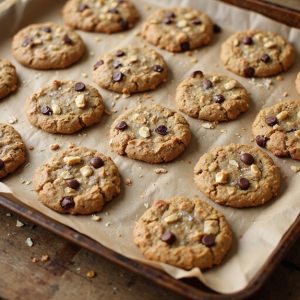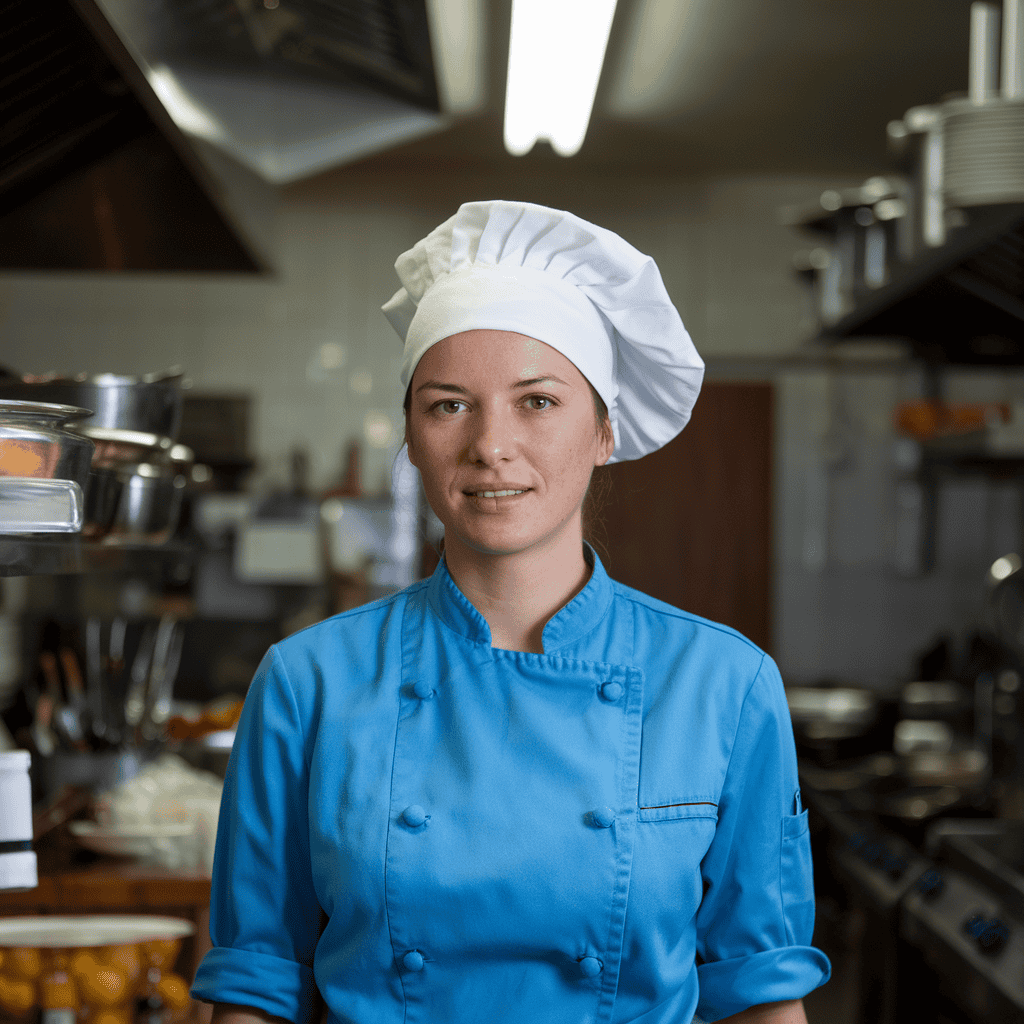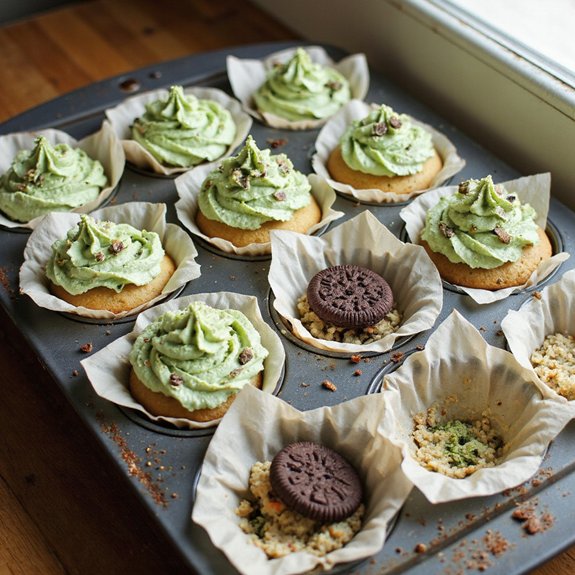Picture pools of amber butter whispering nuts and toffee, oats turning golden at the edges, and the warm, peanutty aroma that fills the kitchen like a hug.
Imagine a cookie that’s tender in the middle, nubbly with oats and peanuts, and just crisp enough to shatter into little sparks of brown-butter caramel at the edge.
That’s why these Brown Butter Oatmeal Peanut Butter Cookies matter to me: they’re comfort you can hold—steadying on busy weeknights, celebratory for Sunday suppers, and perfect for lunchbox surprises or late-night tea.
When my calendar was stacked and my kid’s class needed treats by morning, this dough chilled while we cleared the table, then baked into calm and cheer in under an hour.
They’re unfussy but thoughtful: pantry staples, a quick brown-butter step for depth, and a chill that guarantees thick, chewy centers.
You’ll taste the care in every bite. Ready? Let’s cook!
Why You’ll Love It
- Delivers bold flavor from deeply toasted, nutty brown butter
- Achieves chewy centers with crisp, caramelized edges
- Uses pantry staples you likely already have
- Mixes easily; no fussy techniques required
- Freezes beautifully for fresh cookies anytime
Ingredients
- 1 cup unsalted butter, cut into pieces — brown deeply for nutty flavor
- 1 cup light brown sugar, packed — fresh, soft sugar mixes best
- 1/2 cup granulated sugar — adds crisp edges
- 3/4 cup creamy peanut butter, room temperature — use a no-stir variety
- 2 large eggs, room temperature — bind and add richness
- 2 teaspoons vanilla extract — real extract for best aroma
- 1 3/4 cups all-purpose flour — measure with spoon-and-level
- 1 teaspoon baking soda — check it’s fresh for proper lift
- 1/2 teaspoon baking powder — supports rise and spread
- 3/4 teaspoon kosher salt — balances sweetness
- 2 cups old-fashioned rolled oats — gives hearty chew
- 1/2 cup roasted peanuts, chopped — salted is okay; adjust salt if so
- 1/2 cup mini chocolate chips, optional — mini size disperses evenly
- 2 tablespoons milk, as needed — add only if dough seems dry
Step-by-Step Method
Brown the Butter
Melt butter over medium heat in a saucepan. Stir constantly as it foams, then quiets. Cook until amber with brown specks and a nutty aroma. Immediately pour into a bowl to stop cooking. Cool 15 minutes until just warm. Deep browning boosts butterscotch notes but avoid burning.
Set aside while you prep pans and dry ingredients.
Prep Pans & Heat Oven
Heat oven to 350°F (175°C). Line two sheet pans with parchment paper or silicone baking mats. This prevents sticking and promotes even browning. Position a rack in the center of the oven.
Prepare your cookie scoop and cooling rack so baking flows smoothly. Having everything ready keeps the dough from warming too much.
Whisk the Dry Mix
In a bowl, whisk flour, baking soda, baking powder, and kosher salt until evenly combined. Break up any flour lumps. This guarantees leavening agents distribute uniformly and prevents pockets of baking soda.
Set aside. Keeping the dry mix ready helps you avoid overmixing later when combining with wet ingredients.
Cream Butter & Sugars
In a large mixing bowl, beat the browned, cooled butter with brown sugar and granulated sugar on medium speed for about 2 minutes. Aim for creamy and slightly lightened. This step builds structure and helps dissolve sugars.
Scrape the bowl as needed to ensure even mixing. Don’t overbeat or the dough can spread excessively.
Incorporate Peanut Butter
Beat in the creamy peanut butter until smooth and fully combined, about 45 seconds. Ensure no streaks remain. Peanut butter adds fat and flavor, so integrate it thoroughly for consistent texture.
Scrape the bowl and beater to catch any pockets. A smooth base prevents crumbly dough later when adding eggs and dry ingredients.
Add Eggs & Vanilla
Add eggs one at a time, beating well after each addition. Mix in the vanilla extract until uniform. Properly emulsify so the dough looks cohesive and glossy.
Scrape down the sides and bottom to avoid unmixed bits. Avoid overmixing to keep the cookies tender and prevent toughness from excess gluten development.
Combine Dry Ingredients
Add the whisked dry mixture to the bowl. Mix on low just until a few flour streaks remain. Stop the mixer to avoid overworking the dough. This gentle approach preserves tenderness.
You’ll finish combining when folding in the mix-ins. Overmixing now can make cookies dense and reduce their desirable chew.
Fold in Oats & Mix-Ins
Using a spatula, fold in rolled oats, chopped roasted peanuts, and mini chocolate chips if using. Assess the dough; if it seems dry or crumbly, add milk a teaspoon at a time until it holds together when scooped.
Mix only until evenly distributed. Avoid compacting the oats. Balanced hydration ensures thick, chewy cookies.
Chill the Dough
Cover the bowl and refrigerate the dough for 30 minutes. Chilling firms the fat, reduces spread, and heightens flavor. It also hydrates the oats and flour.
Don’t skip this step for thicker cookies. If chilling longer, let the dough rest briefly at room temperature until scoopable, ensuring consistent portioning.
Portion the Dough
Use a 1.5-tablespoon cookie scoop to portion dough onto prepared sheets, spacing about 2 inches apart. Keep dough mounds tall for thicker centers. If desired, sprinkle lightly with flaky salt.
Return remaining dough to the fridge between bakes. Uniform portions ensure even baking and consistent texture across batches.
Bake Until Just Set
Bake one sheet at a time for 10 to 12 minutes. Look for set, lightly golden edges and slightly underdone centers. Pull the tray when the middle still looks a touch glossy.
Residual heat will finish the bake. For crisper edges, bake to a deeper golden color, watching closely to avoid overbaking.
Cool and Finish
Let cookies cool on the sheet for 10 minutes to set structure. Transfer to a wire rack to cool completely. This rest preserves chew and prevents breakage.
Repeat with remaining dough. Store cooled cookies airtight. For future bakes, freeze scooped dough balls up to 2 months and bake from frozen, adding 1 to 2 minutes.
Ingredient Swaps
- No peanuts: use almond, cashew, or sunflower seed butter; swap chopped peanuts for toasted almonds, cashews, pumpkin seeds, or omit.
- Dairy-free: replace butter with vegan butter (brown-style plant butter if available) or 3/4 cup refined coconut oil; add 1–2 tbsp extra milk alternative if dough is crumbly.
- Egg-free: use 2 flax eggs (2 tbsp ground flax + 6 tbsp water, rested 10 min) or 1/2 cup unsweetened applesauce; expect slightly cakier texture.
- Gluten-free: substitute a 1:1 gluten-free all-purpose blend; guarantee certified gluten-free oats.
- Nut-free: use sunflower seed butter; note possible green tint from chlorophyll (harmless); use seeds instead of nuts.
- Lower sugar: reduce sugars by 1/4 cup total; add 1–2 tbsp milk if needed for scoopable dough.
- Budget/availability: use quick oats (cookies become softer), regular salted butter (reduce added salt to 1/4 tsp), and skip chocolate chips.
- Flavor swaps: add 1/2 cup raisins or dried cranberries instead of chips; use crunchy PB for extra texture; stir in 1/2 tsp cinnamon.
You Must Know
- Doneness • If edges are set but centers look glossy and jiggle slightly at 9–10 minutes, pull the pan; they’ll carryover on the hot sheet for 10 minutes. Why: residual heat finishes setting for chewy centers. Visual cue: edges light golden, centers pale with tiny moisture sheen.
- Troubleshoot • When dough crumbles after adding oats/peanuts, spoon in milk 1 teaspoon at a time until a scoop holds together without cracking. Why: browned butter reduces water. Target: dough pinches smooth with no dry bits; usually 1–2 teaspoons total.
- Avoid • If butter smells sharp or acrid and milk solids are black, discard and start over. Why: burnt butter kills the toffee notes. Anchor: nutty aroma, hazelnut color; remove from heat just as sizzling quiets and specks turn deep amber (about 5–7 minutes).
- Scale • For 12 larger bakery-style cookies, portion 3 tablespoons each and extend time to 12–14 minutes; for minis (1 tablespoon), check at 8–9 minutes. Why: size changes heat penetration. Visual: larger cookies set 1/2 inch in from edge with soft centers.
- Flavor Boost • To amplify peanut depth, toast chopped peanuts on a sheet at 325°F for 8–10 minutes until fragrant, then cool before adding. Why: Maillard compounds enhance nuttiness. Optional: finish dough balls with 2–3 flakes of salt each for pop.
Serving Tips
- Serve warm with cold milk or a creamy vanilla milkshake.
- Plate with sliced bananas and a drizzle of warm honey.
- Pair with coffee or chai; sprinkle flaky salt just before serving.
- Sandwich two with vanilla ice cream for indulgent cookie sandwiches.
- Crumble over Greek yogurt with berries for a dessert parfait.
Storage & Make-Ahead
Store cookies airtight at room temp 3–4 days or in the fridge up to 1 week.
For make-ahead, chill dough up to 48 hours.
Scoop and freeze dough balls on a sheet, then bag; bake from frozen, adding 1–2 minutes.
Baked cookies freeze well 2 months; thaw uncovered.
Reheating
Reheat gently: microwave 10–15 seconds wrapped in a damp paper towel.
Oven at 300°F for 4–6 minutes on a sheet.
Stovetop skillet on low, covered, 1–2 minutes per side.
Grandma’s Bake-Sale Staple
Sometimes nostalgia sneaks up the moment I brown the butter, and I’m back at Grandma’s bake sale table, where these oatmeal peanut butter cookies disappeared before noon.
I remember the glossy jars of pennies, the crinkled cash box, and the scent—nutty, toasty, sweet—pulling neighbors in like a hymn.
I bake them the way she taught me: sturdy enough for a napkin, tender enough to melt after the first bite. The oats give a satisfying chew, peanuts add friendly crunch, and brown butter sings with butterscotch depth.
I keep them modest in size, scoop by scoop, so no one feels shy buying two. A sprinkle of flaky salt makes the chocolate chips wink, and suddenly the plate goes quiet—just crumbs, smiles, and another empty tin.
Final Thoughts
Ready to bake a batch? Give these brown butter oatmeal peanut butter cookies a try as written, or tweak them with crunchy PB, a sprinkle of flaky salt, or mini chips to make them your own!
Frequently Asked Questions
Can I Make These Gluten-Free Without Compromising Texture?
Yes—you can. I swap in a 1:1 gluten-free flour blend and certified GF oats, add 1/4 teaspoon xanthan gum, and chill thoroughly. You’ll still get tender centers, toasty edges, nutty aroma, and joyful, chewy bites.
How Do High Altitudes Affect Baking Time and Spread?
At high altitudes, cookies set faster and spread less. I’d bake a minute less, increase oven 10–15°F, add a tablespoon liquid, and reduce leavening slightly. You’ll get tender centers, bronzed edges, and a confident, even spread.
What’s the Best Way to Ship These Cookies Safely?
Ship them in a snug, airtight tin, layers cushioned with parchment and bubble wrap. I pack pairs, bottoms touching, then nestle the tin in a padded box. Choose two-day shipping, cool packs for heat, and “fragile” labeling.
Can I Halve or Double the Recipe Reliably?
Yes—you can halve or double it reliably. I scale every ingredient, brown the butter the same, watch dough texture, and add milk only if crumbly. Chill times hold; bake by visual cues. Weighing ingredients guarantees precision.
Are There Egg-Free Substitutions That Still Bind Well?
Yes—use 1 flax egg per egg (1 tablespoon ground flax + 3 tablespoons water, gelled). I’ve also had great binding with 3 tablespoons aquafaba or 1/4 cup applesauce; add a touch more oats for structure.

Brown Butter Oatmeal Peanut Butter Cookies
Equipment
- 2 sheet pan
- 1 Parchment paper roll or 2 silicone baking mats
- 1 Medium saucepan
- 2 Mixing bowl
- 1 Stand mixer or hand mixer
- 1 Whisk
- 1 Rubber spatula
- 1 Wooden spoon
- 1 Measuring cups set
- 1 Measuring spoons set
- 1 wire cooling rack
- 1 Cookie scoop 1.5 tablespoons
Ingredients
- 1 cup unsalted butter cut into pieces, browned and cooled
- 1 cup light brown sugar packed
- 1/2 cup granulated sugar
- 3/4 cup creamy peanut butter room temperature
- 2 large eggs room temperature
- 2 teaspoon vanilla extract
- 1 3/4 cup all-purpose flour
- 1 teaspoon baking soda
- 1/2 teaspoon baking powder
- 3/4 teaspoon kosher salt
- 2 cup old-fashioned rolled oats
- 1/2 cup roasted peanuts chopped
- 1/2 cup mini chocolate chips optional
- 2 tablespoon milk as needed
Instructions
- Brown the butter in a medium saucepan over medium heat, stirring until amber with nutty aroma and brown specks, then pour into a bowl and cool 15 minutes to just warm.
- Heat oven to 350°F (175°C) and line two sheet pans with parchment or silicone mats.
- In a bowl whisk flour, baking soda, baking powder, and salt until combined.
- In a large mixing bowl beat browned butter, brown sugar, and granulated sugar on medium speed until creamy and slightly lightened, 2 minutes.
- Beat in peanut butter until smooth and fully incorporated, 45 seconds.
- Add eggs one at a time, beating well after each, then mix in vanilla.
- Add dry ingredients and mix on low just until a few flour streaks remain.
- Fold in oats, chopped peanuts, and chocolate chips if using until evenly distributed; add milk only if dough seems dry and crumbly.
- Chill dough in the refrigerator for 30 minutes to firm slightly for thicker cookies.
- Scoop 1.5-tablespoon portions onto prepared sheets spacing 2 inches apart.
- Bake one sheet at a time for 10 to 12 minutes until edges are set and centers look slightly underdone.
- Cool cookies on the sheet for 10 minutes to finish setting, then transfer to a wire rack to cool completely.





